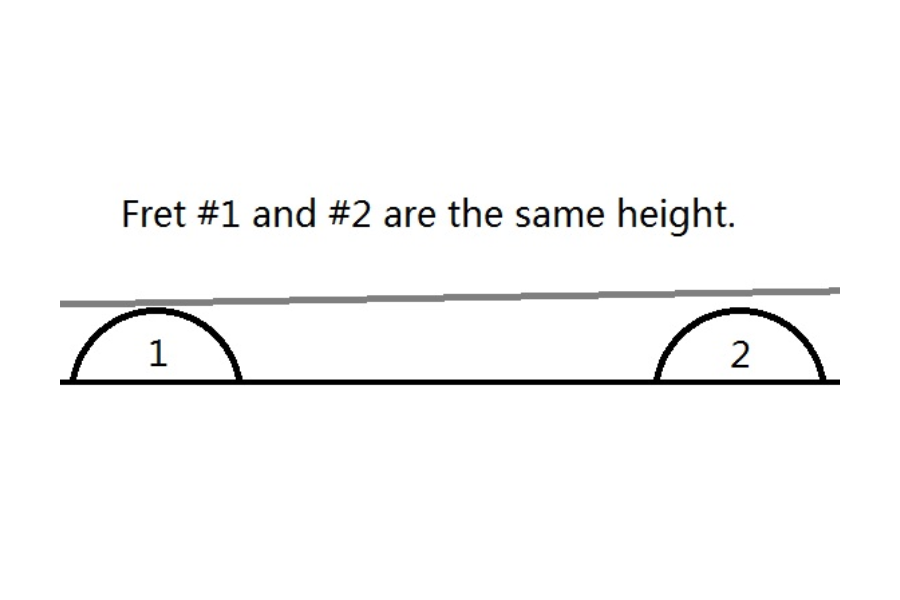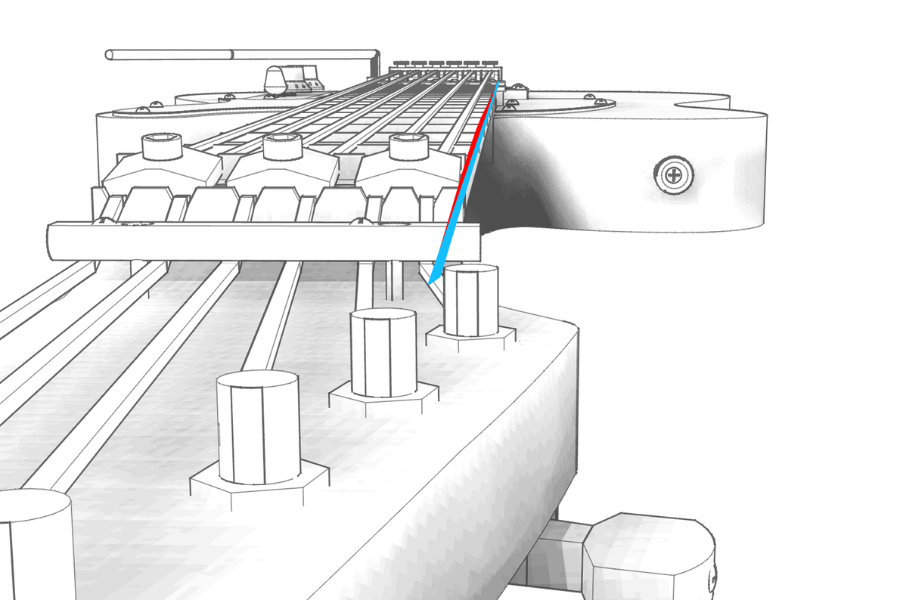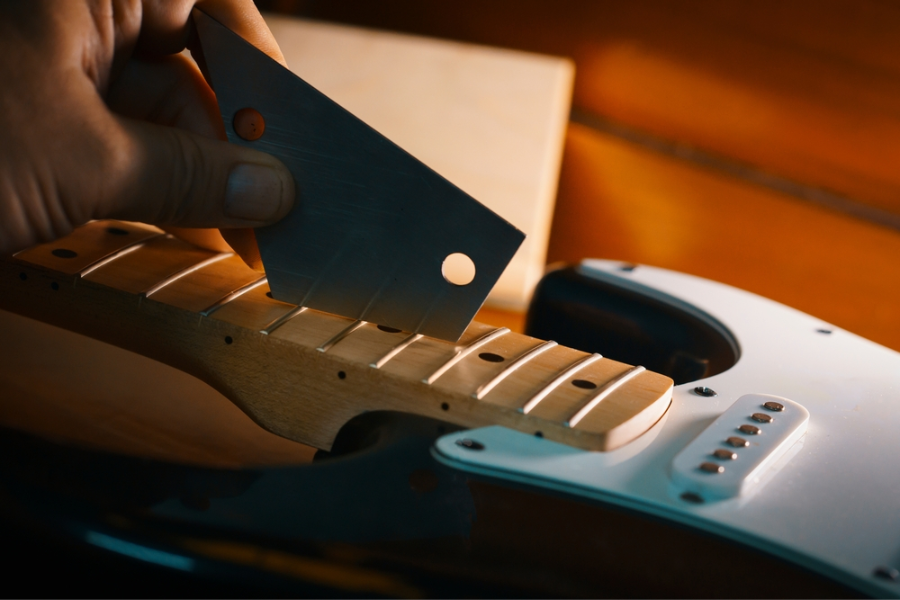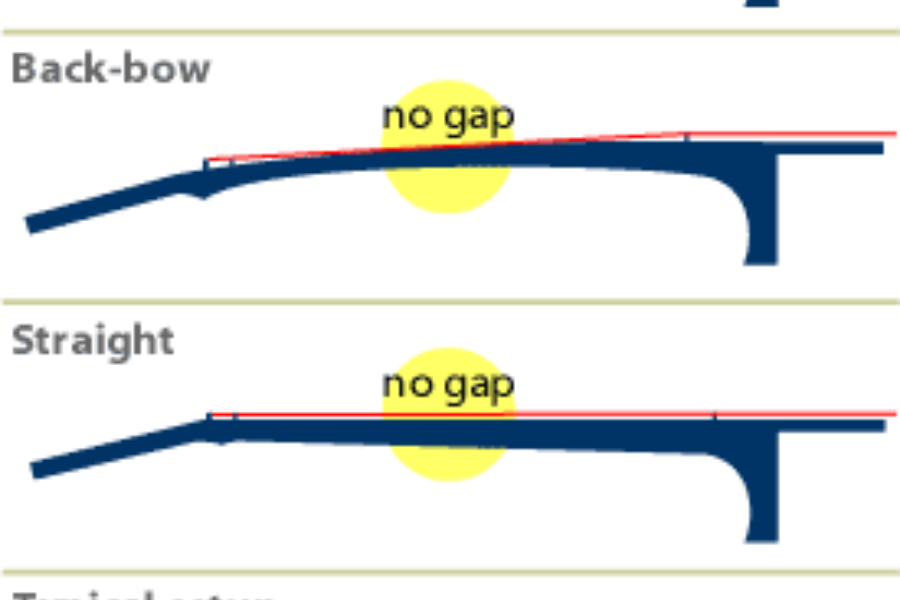Just as you’re about to strike the note in a passionate guitar solo, out of nowhere, a “buzz” interrupts the melody. This problem, named fret buzz, is a common problem with guitars and may drive you nuts. Luckily, when your guitar is buzzing, there’s always a solution. We need to understand what causes fret buzz and how to stop it before we can discuss a typical amount of string buzz.
In this article, Eguitarmania will discuss the common causes of fret buzz and how it affects sound performance. From simple tweaks to more involved improvements, you’ll have a whole toolbox of options. Following our step-by-step instructions, we will help you make the necessary adjustments, enhancing your guitar’s playability.
How To Fix Fret Buzz On Electric Guitar – 3 Common Causes Of Fret Buzz
Follow along closely, and you’ll discover the main reasons to identify the solution. Let’s go buzz-free !

String Action is Too Low
There are a few important things to keep in mind if you want to understand and fix the problems that cause fret buzz when the string movement is too low.
String movement, or how high the strings are above the neck, is a very important part of how well a guitar plays and sounds. Having too little string action could mean that the strings can’t move easily without hitting the frets, which is what makes the popping sound.
This happens a lot with electric guitars because players like smaller motion because it makes the guitar easier to play and lets their fingers move faster. But getting the mix right is very important if you don’t want a fret buzz.
Things need:
- Appropriate screwdriver or Allen wrench.
- Radius gauge that matches the radius of your neck or full set.
- Rulers are marked in 1/16th inch increments.
How to fix:
Changing the bridge saddle height with a hex wrench is usually possible on an electric guitar. This allows precise string height control. Action adjustments may be tougher on acoustic guitars with fixed bridges. Raising the bridge or changing the nut often requires expert assistance.
The truss rod replacement is another key to improving poor action and fret chatter. A truss rod keeps the guitar neck at the appropriate angle to sustain string strain.
Flat or back-bowed necks reduce string-fret spacing, causing fret buzz. The neck should have a slight forward bow (relief) to allow strings to travel freely. The guitar owner can adjust the truss rod, although a professional is typically better. This is particularly true if the guitar has no truss rod or the adjustment doesn’t stop the noise.
Finally, the nut’s condition impacts string movement and fret buzz. Old nuts may cause strings to buzz at lower pitches. If you have poor action and a fret buzz, replacing the nut and bridge may help. Improving the guitar’s tone and handling is complex and may require expert technique.
Frets Are Not In Right Place
If the frets on a guitar are not level with each other, it means that the frets are not all the same height along the neck. This can cause a fret buzz, a sound that you don’t want when the guitar string moves against the higher frets while you play.

In cases where one fret is higher than the other, the guitar string will rattle/buzz. Though the lower notes are shorter, they don’t cause this noise because there’s enough room for the string to move without any problems.
Having different frets at different heights makes it hard to play smoothly. Some notes buzz or, in the worst cases, become “dead” because the string hits a high fret and can’t move easily to make sound.
All frets should be the same height, so the string movement is the same all the way across the neck and there is no fret buzz. There are a number of things that can cause frets to be uneven, such as normal wear and tear, mistakes made during production, or wood moving because of changes in humidity and temperature.
Regular maintenance and setup can help with these problems. Fret leveling is an important part of professional settings that make sure the guitar is playable perfectly.
Things Need:
- A straight edge (a gift card or credit card has about the size and stiffness you’ll need)
- Fretting hammer (I use and recommend this hammer)
- Fret crowning file (the Hosco file is a good size and works well)
How to Fix:
To level the frets, you have to carefully find the frets that aren’t level using a fret hammer and then sand or file the high frets down until they are the same height as their neighbors.
It’s important to be very careful with this process so that you don’t remove too much material, which could cause more problems. Once the frets are level, they need to be re-crowned to get their rounded tops back. This is important for getting the strings to touch and sound right.
Setting the frets is a skilled job that is usually best left to luthiers or guitar techs with a lot of experience. They can check that all the notes are level and that the action is just right so that the guitar is easy to play without buzzing. This process not only fixes the fret buzz issue right away, but it also helps the instrument stay healthy and last longer.
Neck Needs Relief
Knowing that the guitar neck needs to be curved in a certain way so that the strings can move easily without hitting the frets is necessary to understand how important neck relief is for stopping fret buzz. This bend, or “relief,” is very important for keeping the guitar’s tone and ability to be played.

To get fret buzz, especially around the lower frets, make sure the neck of your guitar is not too straight or has a back bow, which means the middle of the neck is higher than the ends. There isn’t enough space between the keys and the strings for them to move freely.
Some common factors that affect the guitar neck are:
Humidity- crack or warp the neck
Ideal humidity levels for a guitar are between 40% to 50%. A too dry environment may cause wood to shrink and crack, while too much moisture can lead to swelling and warping.
Tuning – experience fret buzz
This is because altering the tuning changes the tension on the neck, which can cause it to bow forward or backward beyond its optimal curvature.
String Gauge- improper installation
Heavier strings exert more tension on the neck, potentially leading to an increased curvature (upbow), while lighter strings reduce the tension, which might cause a back bow.
Things need
- A straight edge at least as long as your fingerboard
- The appropriate wrench for adjusting your truss rod
How to Fix:
In many cases, neck comfort problems can be fixed by adjusting the truss rod. Adjusting the neck’s curve is done by tightening or loosening the truss rod that runs along the neck of the guitar.
Letting go of the truss rod can make the neck bow more forward if it is showing signs of back bow. This gives the strings the space they need to avoid buzzing. Adjusting the truss rod can smooth out the neck if it bows forward too much.
Care must be taken when making these changes, as too much twisting or shortening can damage the guitar. Making small changes and re-tuning after each change is suggested to make sure the guitar is set up correctly.
False Playing Technique
It’s something I had to tackle head-on to clean up my sound, and today, I’m here to share what I’ve learned through my journey.
Plucking and strumming fingers
It’s something I had to tackle head-on to clean up my sound, and today, I’m here to share what I’ve learned through my journey. This not only caused a fret buzz but also made my playing sound inconsistent.
I learned to keep my hand relaxed, which surprisingly gave me more control and made my playing sound more fluid. The revelation came when I focused on being gentle and consistent.
Fretting fingers
The fretting hand, pressing down too lightly, or having my fingers too far back from the frets was a recipe for buzz.
The game-changer for me was focusing on finger placement to ensure I pressed down firmly and cleanly. I chose scales and chord transitions as exercises to help me build the strength and precision needed.
How To Prevent Fret Buzz Coming Back?
To prevent the fret buzz from coming back, here’s a breakdown of strategies based on insights from various experts:

Particularly with lower action setups, a certain degree of fret buzz may be considered typical. When playing via an amplifier, the amount of fret buzz on an electric guitar is considered acceptable.
To keep fret buzz away, I’ve learned it boils down to two main points: honing my technique and ensuring my guitar is properly set up.
Technique-wise, it’s crucial to fret notes just behind the fret, use the right amount of pressure, and avoid hitting the strings too hard. These adjustments have drastically reduced the buzz in my playing.
Regarding setup, choosing the right string gauge for my playing style and getting a professional setup have been game-changers. The setup adjusted my guitar’s action and neck relief, tackling buzz issues effectively.
Final Thought
This concludes our in-depth look at how to fix fret buzz on electric guitars. To improve your guitar’s sound quality and handling, we’ve gone over the most important steps, from figuring out the root reasons to putting them into action.









